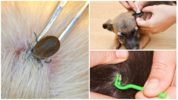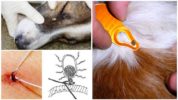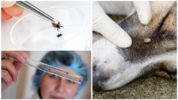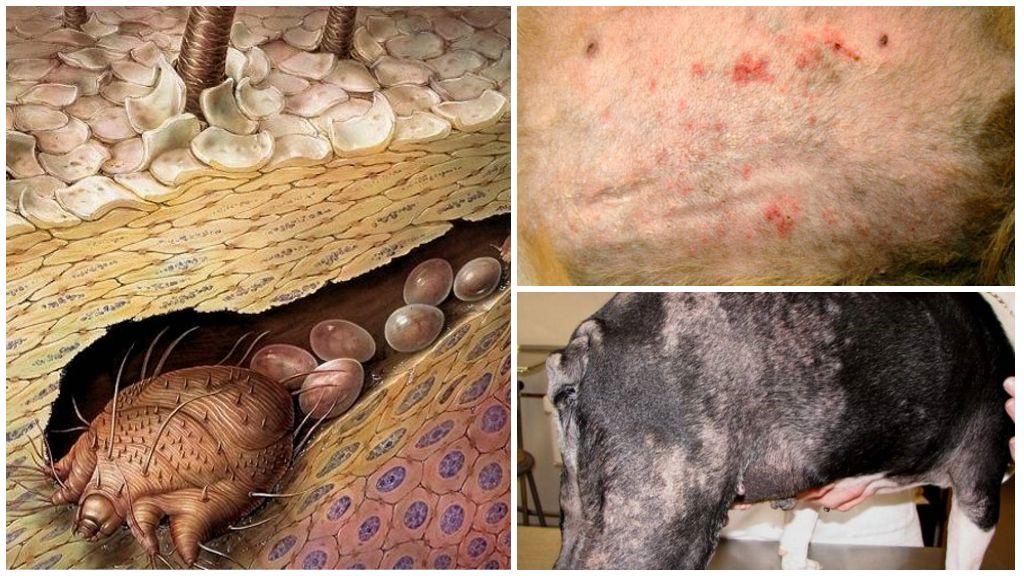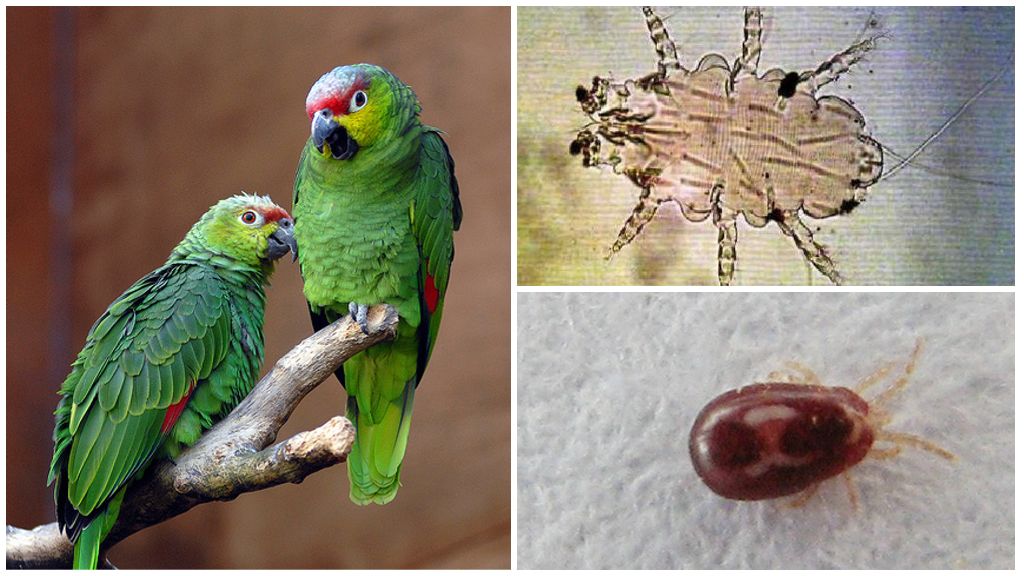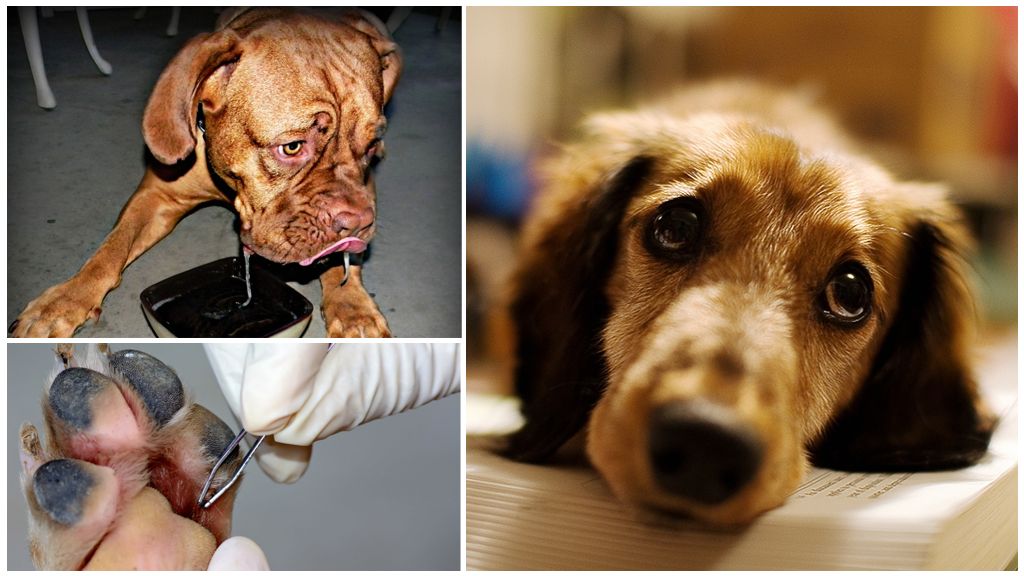- Dog tick extraction
- Dog tick extraction
- Examination of a tick for analysis
With the onset of warm days for dogs and puppies, a dangerous time comes - they are attacked by many blood sucking insects. Mite is one of the most dangerous parasites because it spreads deadly diseases - borreliosis, pyroplasmosis. How to get a tick out of a dog, there are several ways. Use improvised tools that are always available in the household.
Parasite detection
Ticks live in tall grass, in trees, in shrubs. Feels the victim from a distance of 10 m. Once on the body of the animal, for some time it simply crawls in the hair, is examined. After 3 hours, the head is implanted under the skin, sticking the proboscis. In this state, the pest can remain for several days. How many ticks are sitting on a dog, depends on gender, degree of hunger.
You can detect the parasite immediately after returning from a walk, if you carefully examine the dog’s coat and comb it with a comb. This procedure is recommended to be done daily. If the pest has sat down to stick, its round body sticks out from under the skin. When stroking the dog is well palpable through the coat.
Important!
If a dangerous parasite is found on the dog’s body, do not rush to try to get rid of it. The pest will not go anywhere, it will remain stuck in the same place. To remove the tick from the dog, you need to arm yourself special toolcarry out preparatory procedures.
How to remove a tick in a dog
There are several ways to properly remove a pest.
Elementary tools:
- thin but strong thread;
- tweezers;
- needle;
- alcohol;
- vegetable oil;
- petrol;
- brilliant green;
- iodine.
On a note!
For those who have had to deal with a parasite many times, getting a tick is quite simple. It is necessary to pick up with nails, as close as possible to the base, pull sharply. However, this procedure is not recommended for beginners, since there is a high probability that the head will remain under the skin. The pest can bite under the skin deep enough.
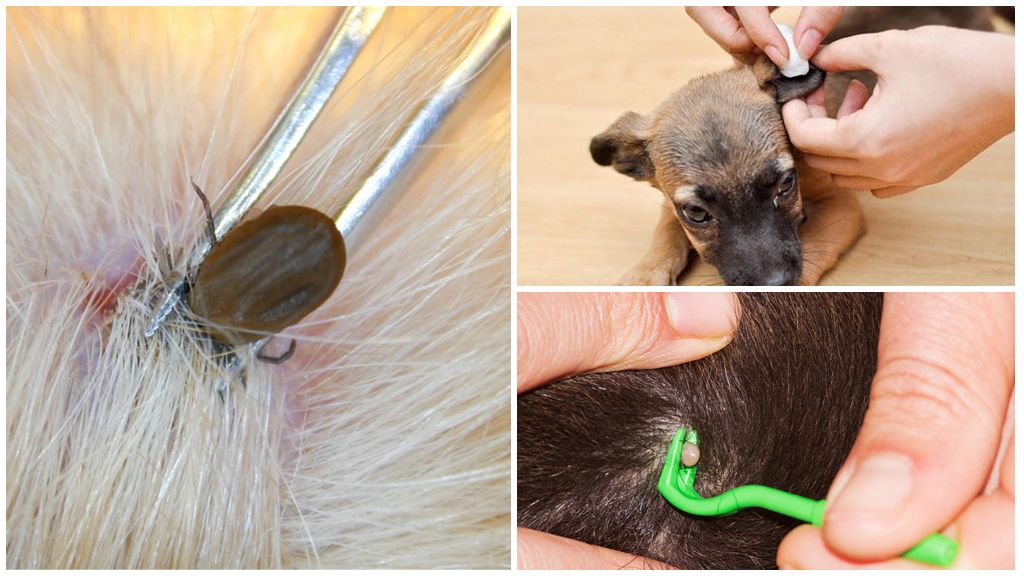
Skin treatment
Removing a tick in a dog begins with humane action. They treat the skin around with an oily substance or alcohol. Use sunflower, olive oil, gasoline, kerosene, machine oil, solid oil, medical alcohol, vodka. Everything that was near or at hand. When using combustible mixtures, you need to take their minimum amount, so as not to burn the epidermis, to protect against allergies.
Substances block oxygen pest, causing it to get out. Unpleasant stay of the parasite in the same place, the pungent smell of the substances used.
On a note!
You can remove the tick in this way in 20-30 minutes. You need to constantly monitor the process in order to manage to remove the pest from the wool.
The main tool is tweezers
If you did not succeed in extracting the tick by the previous method, proceed to the following actions. Pre-treatment of the skin causes the pest to move closer to the surface of the skin. Removing the tick will be much easier.The main tool is tweezers.
Gently press at the base of the head, begin to make circular movements, as if twisting the body of the pest. In which direction to turn the tick, there is no general opinion. Most insist that you need to rotate counterclockwise. Others say that you can manually remove it in a circular motion in any direction, but you can not alternate. If you started to turn to the right, do not start to turn to the left.
Important!
With tweezers, you should not press the body too hard. If the chitinous cover is damaged, blood will appear, which can enter the open wound. This is how infection with dangerous diseases occurs. If you carefully unscrew the tick, infection can be avoided.
Thread application
You can remove the tick from the dog at home using a thread. In this way, small parasites are removed or if they did not have time to get much under the skin. Make a loop with a thread, throw it on a sucking tick at the very base. Swing from side to side, then sharply pulled out.
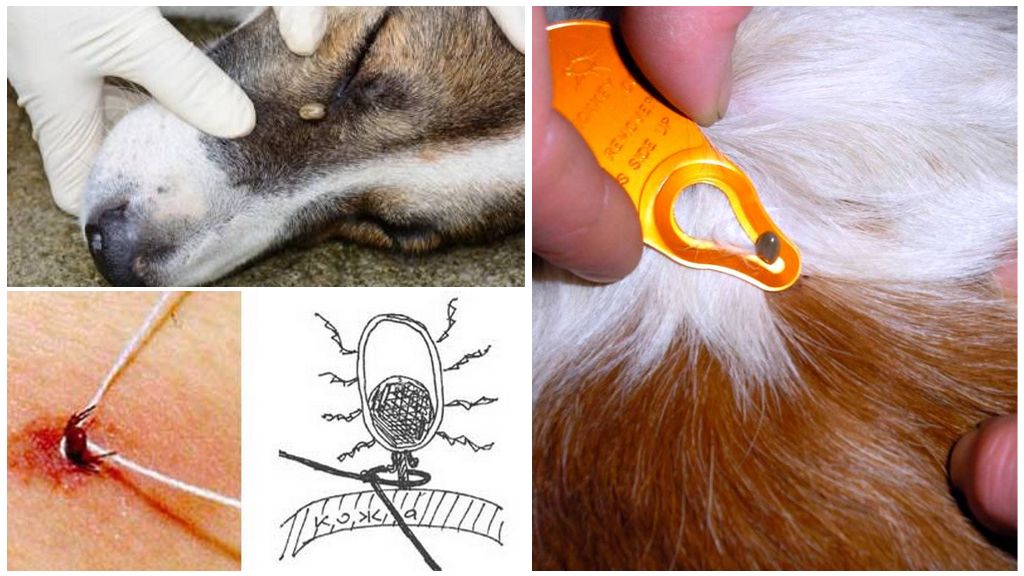
If a large tick is stuck, there are no tweezers at hand, you can also use a thread. Draw a loop, begin to gently twist. Enough 2-5 scrolls to remove the parasite from the body of the animal.
Syringe
Pull out tick with syringe can be very fast. Preliminarily, a “tool” should be prepared.
- The radius of the syringe should be as close as possible to the size of the body of the parasite. Cut off the tip where the needle is to be inserted. Do this with a sharp knife so that the syringe fits snugly against the skin.
- The edges are treated with vegetable oil or cream. This will provide better sealing.
- A syringe is placed, covering a serene dinner parasite. After a few seconds, the piston is pulled up.
After this procedure, the pest will begin to get out.
On a note!
Using a twisting method, a parasite is taken out of the dog’s ear, neck, and body. After the procedure, treat the wound with alcohol, brilliant green or iodine. If you are afraid to do it yourself, you need to take the pet to the veterinarian. Leaving under the skin is dangerous for the dog’s health. Removing a dead parasite is much easier because it does not resist, but waiting until it dies is unreasonable.
What to do if the head of the tick remains in the body of the dog
It is not always possible to carry out the procedure according to all the rules, the head of the parasite can remain under the skin. The pest, after introducing the proboscis, expands its forceps in such a way that they interfere with the reverse movement. With a sharp movement, the head simply breaks away from the body.
It is impossible to leave part of the foreign body under the skin of the dog. As the wound begins to inflame, chase, which will cause the animal severe discomfort, pain. You can pull out the tick head in the same way as it is done with a splinter. Disinfect the wound with any alcohol-containing product. Pre-process the needle. Carefully remove the rest.
What to do with a tick after removal from a dog
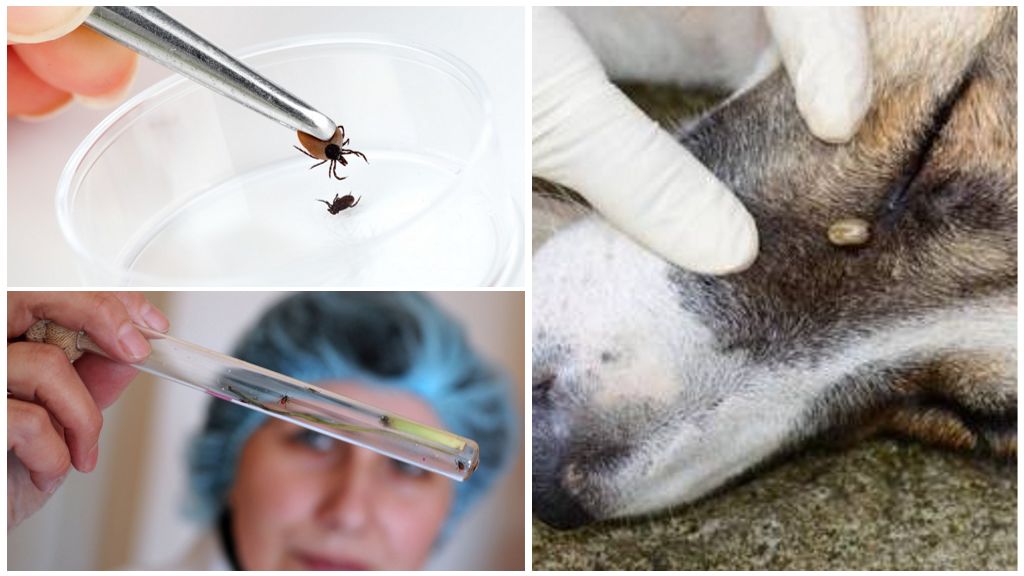
To make sure that the dog is not in danger of a dangerous disease, it is recommended to put the pest in a jar, send to the laboratory. If a virus is detected in the body, you should seek the help of a veterinarian.
On a note!
In the absence of a dangerous disease, the wound will heal without consequences within 5-7 days. Removing the tick safe and sound reduces the chances of infection, but does not completely exclude it.
If outbreaks are not detected in a specific area tick-borne dangerous diseasesthere is no danger. With the correct extraction of the parasite, the wound heals well even without special treatment. Another question is what to do after the dog has been pulled out.
It’s not worth pushing, because there may be a virus in the blood. You can’t throw him out into the street, because he will find himself another victim, it may even be a person. Experts recommend burning.
Effects
If you do not remove the tick from the dog, there are several options for the development of the situation:
- After a while, he himself will crawl out, leave the victim.
- Or inflammation, redness, swelling, itching will begin. The dog will begin to scratch the skin, comb the wounds. A secondary infection will join, which is dangerous by the development of pustules, ulcers.
- If you do not rid the dog of ticks, she will try to do it herself, clutching her teeth. In this case, the head may remain under the skin or a deadly disease virus will enter the bloodstream.
If the parasite is safely removed, the wound drags on quite quickly, without causing complications. Immediately after the extraction procedure, you need to sanitize a wound. Use any product containing alcohol, brilliant green, iodine.
In a situation, if an allergic reaction appears after a tick bite, antihistamines for oral administration, anti-allergic ointments are used. A specialist should prescribe treatment. The location of the veterinarian in Moscow can be seen on the map via the Internet.
